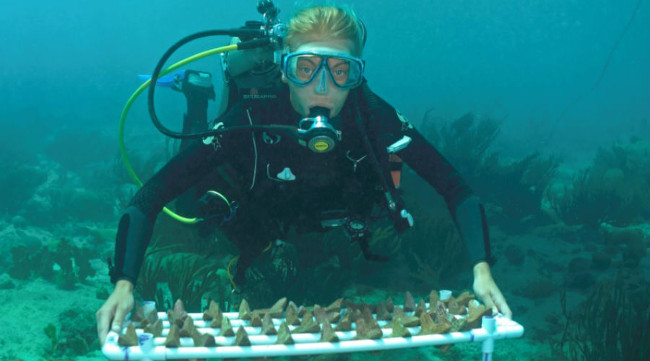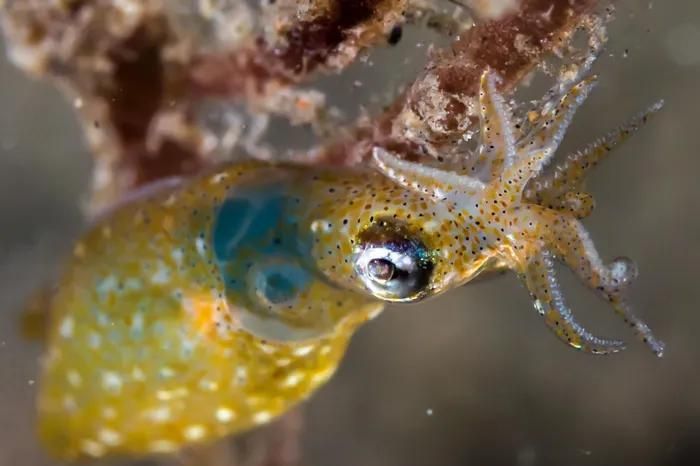Concrete bubbles promise to help restore coral reefs faster
Usually, when conservationists try to recover dead or dead coral reefs, they perform it manually by forcing coral fragments to live with existing reefs. It is a complicated and time consuming process. Thanks to the new technology developed by the SECORE International marine ecology group, coral reefs can recover as quickly and easily as sowing in the garden.
As part of a pilot project taking place in Curaçao, the researchers began by collecting larvae developed by coral colonies (Favia fragum) at a local coral reef. In a laboratory, the larvae were then deposited in a small rectangular concrete structure. A few weeks later, after the larvae have stabilized into coral polyps on concrete, these structures are called coral seed bases that are put into simple coral reefs by hand - insert them into the slots. available.

A year later, more than half of these "seed facilities" have at least one growing coral. This number may be higher if the algae grow on the sun's surface around the seed structure.
According to SECORE, transplanting about 10,000 individuals per hectare of coral reefs using traditional methods takes several hundred to several thousand hours. Conversely, using new technology, the same task can be completed under 50 hours.
Dr. Dirk Petersen, project director, said: "So far, the number of coral seed substrates is limited because they are produced by hand with molds. We are cooperating with partners. Our to perform production of tetrapod substrates on an industrial scale, in large quantities and significantly lower costs " .
"If we can combine new cultivation methods with more efficient coral larval rearing techniques that we are currently developing, the cost of coral reef recovery may be lower than the cost of efforts. force to restore existing mangrove forests and marshes " .
See more:
- Horror secret at the island of humans do not dare to set foot
- Found shelter for corals threatened by global warming
- Three new species of crustaceans are found in coral reefs throughout the Indian Ocean and Pacific Ocean
You should read it
- Coral reefs are threatened by ocean acidification, which can disintegrate before 2100
- NASA created a game that lets you help map the ocean's coral reefs
- Found shelter for corals threatened by global warming
- Science warns: 70-90% of corals will disappear in the next 20 years, and become extinct in 80 years
- Scientists develop sun shields to prevent coral bleaching
- Google introduced Coral, the platform that supports building AI IoT hardware integration
- Three new species of crustaceans are found in coral reefs throughout the Indian Ocean and Pacific Ocean
- Eels longer than 2m tear up the 'cousins' mercilessly
May be interested
- Top 5 concrete drills for civilians
 concrete drill is a tool used to drill and destroy concrete in the construction industry. the following article will introduce you to the top 5 most popular and best-selling concrete drills on the market today.
concrete drill is a tool used to drill and destroy concrete in the construction industry. the following article will introduce you to the top 5 most popular and best-selling concrete drills on the market today. - Why is Roman concrete 2,000 years ago more sustainable than modern concrete?
 the ancient roman ports of concrete built 2000 years ago still exist firmly until now. meanwhile, many modern works today have less than half durability and have a lifespan of less than 100 years.
the ancient roman ports of concrete built 2000 years ago still exist firmly until now. meanwhile, many modern works today have less than half durability and have a lifespan of less than 100 years. - Eels longer than 2m tear up the 'cousins' mercilessly
 his gigantic moray eel has quickly dominated the fierce battle with the sea eel.
his gigantic moray eel has quickly dominated the fierce battle with the sea eel. - How to Remove Air Bubbles Under Screen Protector
 screen protectors help protect electronic devices from cracking and breaking; however, air bubbles may appear on the sticker if you do not apply it correctly or the screen is not completely flat. after applying the screen protector, it is difficult to remove the air bubbles in the middle, unless you remove the screen protector and reapply it. if air bubbles appear on the edge of the patch, you can use cooking oil to quickly remove them.
screen protectors help protect electronic devices from cracking and breaking; however, air bubbles may appear on the sticker if you do not apply it correctly or the screen is not completely flat. after applying the screen protector, it is difficult to remove the air bubbles in the middle, unless you remove the screen protector and reapply it. if air bubbles appear on the edge of the patch, you can use cooking oil to quickly remove them. - Unique new species of squid, super small 1cm, hunts by sitting still
 scientists have discovered two new species of dwarf squid, only about 1cm in size, living on coral reefs in japan.
scientists have discovered two new species of dwarf squid, only about 1cm in size, living on coral reefs in japan. - Google introduced Coral, the platform that supports building AI IoT hardware integration
 in addition to a series of other machine learning projects recently, google today has officially announced a new platform, supporting the construction of smart hardware devices with integrated ai. name coral.
in addition to a series of other machine learning projects recently, google today has officially announced a new platform, supporting the construction of smart hardware devices with integrated ai. name coral. - PhotoShop - Create water bubbles
 sometimes in photos, you want to add some water bubbles to make it more vivid and perfect. this exercise will guide you to create very lively water bubbles.
sometimes in photos, you want to add some water bubbles to make it more vivid and perfect. this exercise will guide you to create very lively water bubbles. - Three new species of crustaceans are found in coral reefs throughout the Indian Ocean and Pacific Ocean
 three new species of crustaceans were discovered by researchers at ryukyus university and kagoshima university, japan and palau international reef center.
three new species of crustaceans were discovered by researchers at ryukyus university and kagoshima university, japan and palau international reef center. - Scientists develop sun shields to prevent coral bleaching
 a group of scientists has developed a sun visor they hope could help prevent coral bleaching, spreading throughout the great barrier reef in australia in 2016 and 2017, the great barrier reef foundation (gbrf). said.
a group of scientists has developed a sun visor they hope could help prevent coral bleaching, spreading throughout the great barrier reef in australia in 2016 and 2017, the great barrier reef foundation (gbrf). said. - How to Create Speech Bubbles in PowerPoint
 powerpoint also has details for you to illustrate your presentation, such as creating speech bubbles in powerpoint.
powerpoint also has details for you to illustrate your presentation, such as creating speech bubbles in powerpoint.










 Birds are adapting to climate change because of their genes
Birds are adapting to climate change because of their genes The first photosynthesis happened about 1.25 billion years ago
The first photosynthesis happened about 1.25 billion years ago Ocean acidification changes California's shell structure
Ocean acidification changes California's shell structure Scientists discover what's left of the oldest Antarctic creature
Scientists discover what's left of the oldest Antarctic creature Asian regional mapping scientists are prone to earthquakes in the hope of mitigating natural disasters
Asian regional mapping scientists are prone to earthquakes in the hope of mitigating natural disasters The ocean is losing 'breath'
The ocean is losing 'breath'